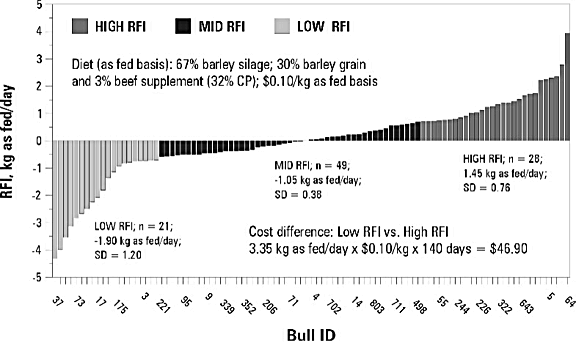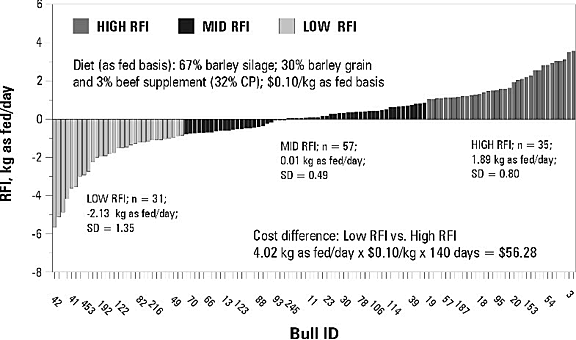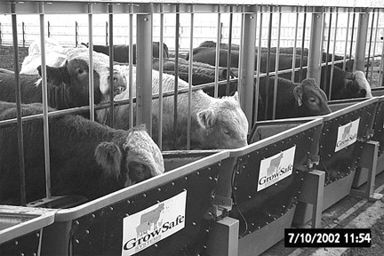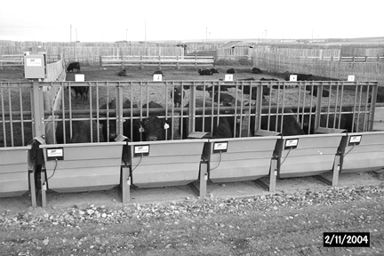| | Benefits | Residual feed intake | Research | Results | Value of residual feed intake | Selecting for residual feed intake
Improving the feed efficiency of a beef cattle herd can mean big savings for producers. One way to achieve this goal is to select breeding bulls that are naturally feed-efficient, since 80 to 90 per cent of the genetic improvement in a herd comes through the sires.
Benefits
On average, it costs $50 less over 112 days to feed an efficient bull compared to an inefficient one. An efficient bull will pass on superior genetics for feed efficiency to his progeny, which will be realized as feed savings for calves in the feedlot and for replacement heifers entering the cowherd.
Feed is a major expense for cattle producers, second only to fixed costs. With 75 per cent of the total feed cost used for maintenance in breeding cows, improving feed efficiency can have a big economic effect.
A 5 per cent improvement in feed efficiency could have an economic effect four times greater than a 5 per cent improvement in average daily gain. Improving feed efficiency will have an effect on the unit costs of production and the value of breeding stock, embryos, semen and feeder animals.
Residual Feed Intake
Residual Feed Intake (RFI) or net feed efficiency is defined as the difference between an animal's actual feed intake and its expected feed requirements for maintenance and growth. RFI is the variation in feed intake that remains after the requirements for maintenance and growth have been met. Efficient animals eat less than expected and have a negative or low RFI, while inefficient animals eat more than expected and have a positive or high RFI (see Figures 1 and 2).
Considerable variation in RFI exists among individual animals within breeds or genetic strains. This variation suggests that substantial progress can be made in RFI since the heritability of the trait is about 40 per cent.

Figure 1. Individual animal variation in RFI for 98 British bulls tested at Olds College from November 2002 to February 2005.

Figure 2. Individual animal varation in RFI for 123 Continental bulls tested at Olds College from November 2002 to February 2005.
Research
In the early 2000s, Dr. John Basarab and colleagues were the first in North America to integrate the concept of RFI with new advances in radio frequency (RF) identification, wireless communication, RF detection, data acquisition and computer software integration (GrowSafe Systems Ltd., Airdrie, Alberta, Canada).
Their results were also the earliest in North America to show the relationships between RFI and carcass characteristics, body composition, heat production, methane and manure production. They were the first to uncover the economic potential associated with selecting beef cattle for RFI.
Based on this proof of concept work, a three-year feeding trial was organized and conducted at Olds College to identify feed efficient breeding bulls and to demonstrate the RFI technology to the beef industry. The trial made use of the GrowSafe System to measure individual animal feed intake (see Figure 3).
Approximately 80 bull calves, averaging 7 to 8 months of age, were tested for RFI over a 140-day bull test each year. The genetic make-up of the group was 12 to 16 bull calves from each of 5 major seed-stock breeds in Alberta. In the second and third year a sixth breed was added. Each group of 12 to 16 consisted of 3 to 4 half sibling groups of 4 bull calves (4 sons of the same sire/half sibling group).
The trial started with a 28-day adjustment period, followed by a 112-day test period. Each animal was weighed every 14 days and measured for hip height and body condition score. Back-fat thickness, rib-eye area and marbling score were measured using real-time ultrasound every 28 days. The adjustment and test period diets were similar to those used in standard bull test stations.

Figure 3. GrowSafe System used for measuring RFI of bulls at Olds College.
Results
Background information on the trial, results by year and biological type (British, Continental) and by breed type ranked by economic index, as well as presentations made at the June 9, 2005 results meeting can be viewed on Alberta Agriculture's website.
Research in Alberta and Australia shows that selection for low RFI can have significant results:
- lower maintenance requirements of the cow herd by 9 to10 per cent
- reduce feed intake by 10 to 12 per cent
- have no effect on average daily gain or mature size
- improve feed conversion ratio by 9 to 15 per cent
- slow gain in empty body fat by 4 per cent, but still grade A, AA or AAA.
- lower weights of liver, stomach and intestines
- have no effect on distribution of 9 wholesale cuts
- improve calf-weight-per-cow feed intake by 15 per cent
- lower methane emissions by 25 to 30 per cent
- reduce manure nitrogen, phosphorus and potassium production by 15 to 17 per cent
- efficient growing animals are efficient as adult cattle
- progeny of efficient beef cattle are also more efficient than those of less efficient cattle
Value of Residual Feed Intake
The economic potential, accrued after 15 to 25 years of selection for RFI, is estimated at $109 million annually for Alberta's feeder cattle industry and at least as much for cow-calf producers.
Improving RFI is expected to reduce methane and manure emissions from cattle by 15 to 20 per cent, which, in turn, may result in new agriculture investment due to greenhouse gas credits.
Selecting for Residual Feed Intake
Dr. Denny Crews, a beef quantitative geneticist with Agriculture and Agri-Food Canada, generated the first North American expected progeny differences (EPDs) for RFI on 221 bulls from the Olds College test. Accuracy values for the RFI EPD averaged 59 per cent and will increase with more RFI bull and progeny testing.
Dr. Crews also developed a multi-trait economic index that includes average daily gain, 365-day weight and RFI. This index will aid in genetic selection by ranking bulls according to how well and how economically their progeny perform in the feedlot. Higher index values (mean = 100, range = 78.6 -165.1) are associated with bulls with higher growth rate, lower daily intake and improved efficiency. In addition to being more desirable as yearlings on test, these high-index bulls are expected to sire calves that generate more net revenue in the feedlot segment of the industry.
Cattleland Feedyards (Figure 4), the largest bull test in Canada, has invested $1 million into a new research and RFI testing facility for breeding stock (see figure 4) and have the capacity for RFI testing 320 head per test with the possibility of running 2 tests per year.

Figure 4. GrowSafe equipment set up in Cattleland Feedyard's bull testing facilities near Strathmore, Alberta.
The Cattleland RFI Bull Test has allowed more producers to participate in RFI testing to identify efficient sires and learn about the potential of this new technology in breeding programs to improve production efficiency and competitiveness. Breeders interested in testing their bull calves or replacement heifers for RFI should contact Scott McKinnon, Research and Bull Evaluation Manager at Cattleland Feedyards.
In addition, research at the Lethbridge Research Centre and at the University of Alberta is focusing on understanding the relationship between feeding behavior and RFI.
The Bovine Genome Project, lead by Dr. Stephen Moore, bovine genomics chair, University of Alberta, Edmonton, is presently identifying genetic markers for RFI that will have commercial application and will aid in future selection programs.
Contacts:
Dr. John Basarab - Senior Research Scientist,
Alberta Agriculture and Forestry, Lacombe
Phone: (403) 782-8032
Dr. Susan Markus – Beef Research Scientist,
Alberta Agriculture and Forestry, Stettler
Phone: (403) 742-7570
Source: Agdex 420/11-1. July 2006. |
|